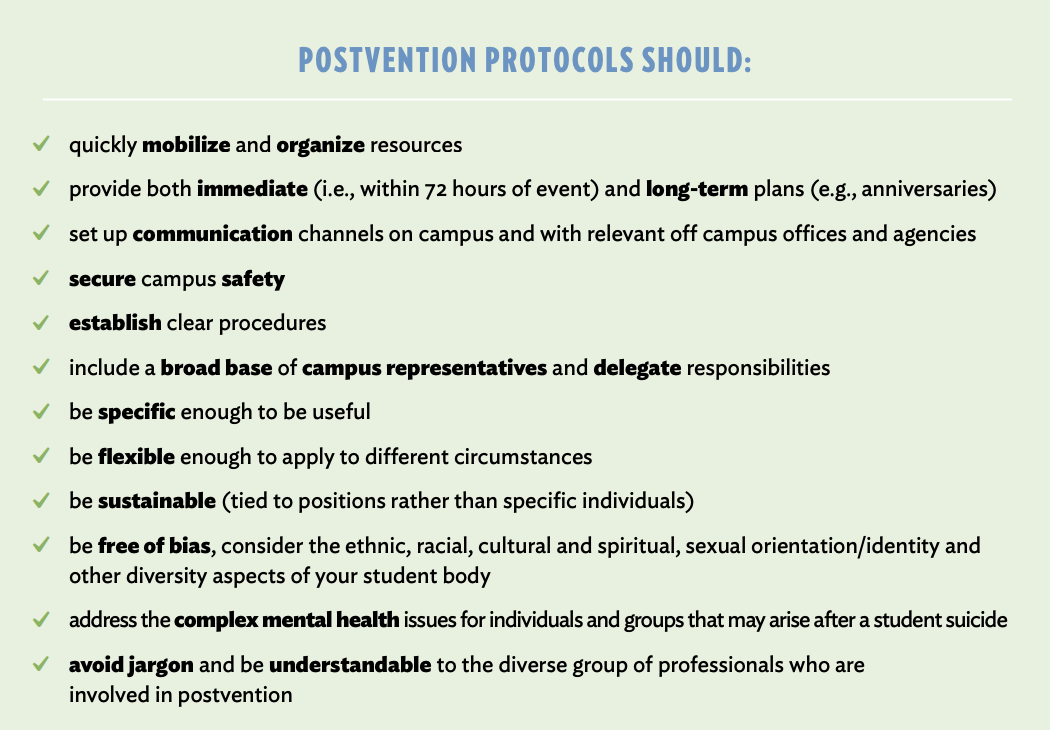COVID-19 has undeniably exacerbated the mental health crisis facing college students. In just the past three months, at least six student athletes, Sarah Shulze, Katie Meyer, Jayden Hill, Robert Martin, Lauren Bernett and Arlana Miller, have taken their own lives. Suicide ranks as the second leading cause of death for college students and it is estimated that 1,100 suicides occur on college campuses every year.
Suicide Contagion
Research has shown that when a student tragically dies by suicide, there is an increased risk of additional suicides. This is known as suicide contagion. According to the CDC, U.S. teenagers and young adults are the groups most likely to experience contagion. In the past year, numerous suicide contagion clusters, where multiple students died by suicide in short succession to one another, have been identified throughout the country:
Prevention + Postvention
A comprehensive solution to prevent suicide from ever occurring on college campuses does not exist, but there is significant research surrounding suicide postvention techniques that, if deployed correctly, can effectively decrease the likelihood of suicide contagion following a student’s death. Recognizing this, higher education institutions of all sizes and complexities share a responsibility to devote campus resources to suicide prevention and postvention planning.
1
Postvention Planning Goals
According to the HEMHA, when a student dies by suicide on campus, postvention efforts can help the “campus community get back to their pre-crisis level of functioning and develop new skills for dealing with challenges in the future.” To achieve this, an effective suicide postvention strategy should:
-
- Help individuals or groups impacted by suicide cope with the current trauma, while also reducing the “intensity of an individual’s or group’s emotional, mental, physical and behavioral reactions to a crisis.”
- Stabilize the university’s community, restore “some semblance” of a campus routine and help guide the community back to its pre-crisis level of functioning.
- Limit the risk of further suicides and “imitative suicidal behavior through contagion.”
- Assist students, faculty and staff solve potential problems in an effort to enhance independent functioning following a crisis.
- Facilitate understanding so the campus community can process the tragedy that occurred, express difficult emotions, and digest the overall impact of the event.
- “Avoid institutionalizing grief,” such as when the “memory of a campus suicide becomes ingrained in the institution to the point that it becomes difficult to remember the community as safe or without grief.”
- Create opportunities for learning and improvement for “future prevention, postvention and response efforts.”
An important note on privacy: respecting a family’s privacy should always be a top priority for university administrators when responding to a campus suicide.
2
Forming a Postvention Committee
The first step of a postvention plan involves establishing a team of key stakeholders who will act as postvention coordinators and be responsible for developing intervention guidelines that meet specific campus needs. An example of a school that has successfully implemented its own postvention committee is the University of Alabama at Birmingham. Notably, UAB’s suicide prevention task force illustrates how HEMHA’s guidelines on forming a postvention committee can be translated into action:
-
- For instance, UAB formed its suicide prevention task force proactively, meaning it did not wait for a campus suicide to happen before establishing its protocol. Precrisis planning is crucial because “in the aftermath of a campus suicide, when emotions and tensions are high, it is very difficult to respond without having guidelines or plans in place.”
- It gave the task force a specific purpose: “Members serve a critical role in developing comprehensive, collaborative, and coordinated plans for suicide prevention and overall well-being of students.”
- Its task force included members from a wide breadth of university departments, such as counseling services, residence life and even the UAB Police Department.
- Its task force appointed a Chair (or lead coordinator) that will be responsible for “responding to all questions about the protocol.” Moreover, UAB’s decision to appoint Angela Stowe, Director of Student Counseling Services and Wellness Promotion, works in accordance with HEMHA’s suggestion to appoint a lead coordinator who possesses experience “managing student deaths or suicide response processes” and serves as a “trusted figure in the campus community.”
Ultimately, HEMHA’s research suggests that “effective interdisciplinary coordination and communication after a campus suicide can streamline postvention efforts, reduce errors and provide comprehensive support to the community.”
An important note on privacy: The campus media office, the counseling director and the legal affairs office should work together to educate the postvention committee about potential safety and privacy concerns.
3
Drafting a Postvention Protocol
According to HEMHA, when in the beginning phases of postvention planning, “it is important to ask questions about your campus’s unique needs and resources” to gain deeper understanding of where additional resources should be allocated and which specific areas of improvement require the most attention. Different schools will have different access to resources and will be forced to adjust their plans to what will work for them. This is okay. Postvention plans are not designed to be replicated, rather customized to fit the exact needs of any school looking to improve the mental health resources offered to its students. An example of a school that has crafted and implemented a prevention protocol specifically tailored to the campus community’s needs is the University of California, Davis. For example, UC Davis:
-
- Clearly outlined the purpose of its postvention committee, detailed meeting frequency, as well as Ad Hoc incident protocol, and established requirements for committee membership.
- Listed specific steps aimed at achieving campus-wide coordination in the case that a student death on campus does occur.
- Suggested different ways to support students facing a crisis, such as recommending counseling services or extending deadlines for coursework and examinations.
- Established a policy that it would not release names or cause of death to individuals “out of respect for a student’s next of kin and community,” noting that the name of the student may be announced if “the family of the deceased student requests or authorizes a university announcement or memorial service.”
4
Postvention Messaging Considerations
-
- There is no exact formula for carrying out postvention communications and the “process will depend on how information unfolds over time.”
- However, timing is crucial.
- “A small amount of help given quickly will be more effective and efficacious than a large amount of help given later when the individual’s/survivor’s/ campus’s receptivity has lessened.”
- This is why proactively establishing protocols before a student’s death is so critical.
- The postvention committee must determine which platforms it will use to communicate with students, campus faculty and staff, and outside media.
- The information shared in the school’s communications will depend on the setting, what is known and what the desires are of the survivors, once again reflecting the importance of consulting affected family members.
- Always remember that, when communicating about suicide, anxiety on campus may increase if information is too vague or limited.
- Moreover, the risk of contagion “is enhanced” when details, such as method of suicide, are emphasized or when the suicide is “dramatized or romanticized.”
- For more suggestions on safe messaging, consult the Framework’s guide to successful messaging.
- HEMHA recommended “written statements that can be distributed to everyone in the campus community, usually via campus-wide e-mail,” as the most efficient strategy for providing details on a student’s death.
While postvention plans allow some room for customization, HEMHA advised that every suicide postvention protocol should at least:


